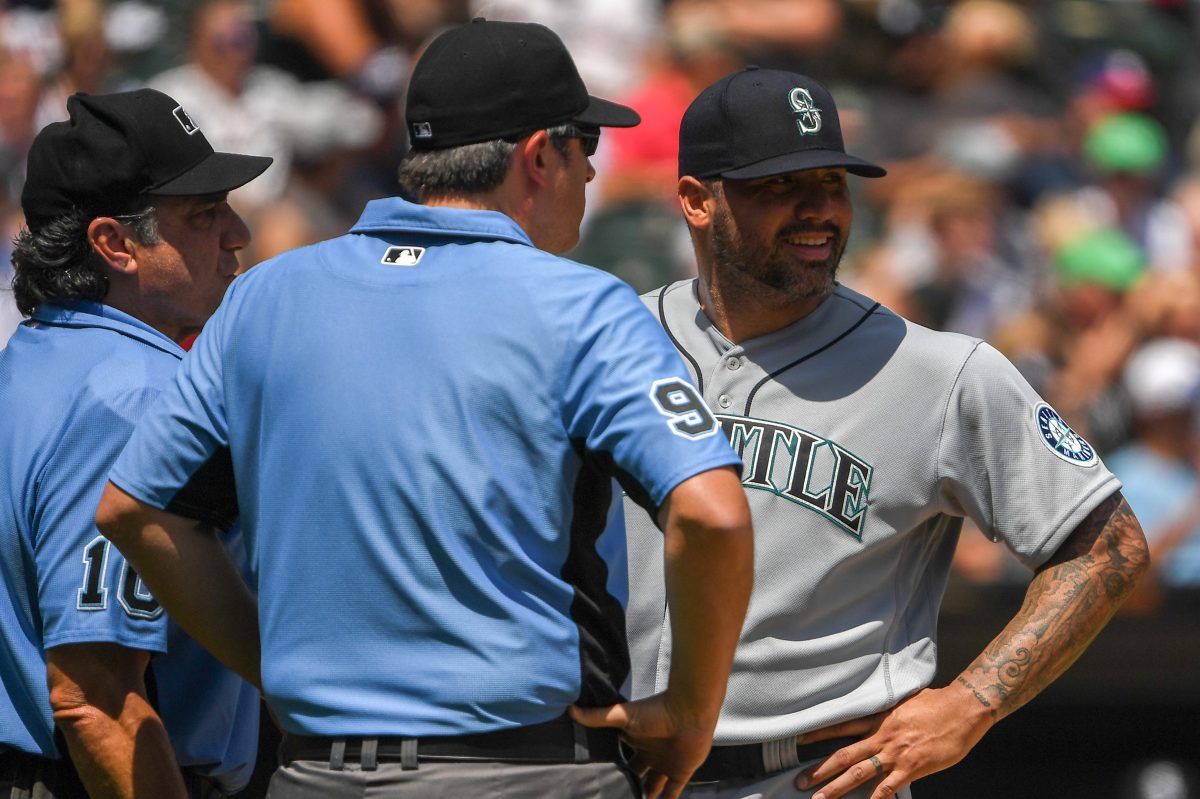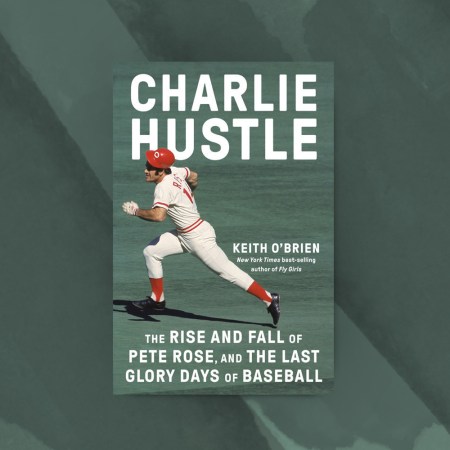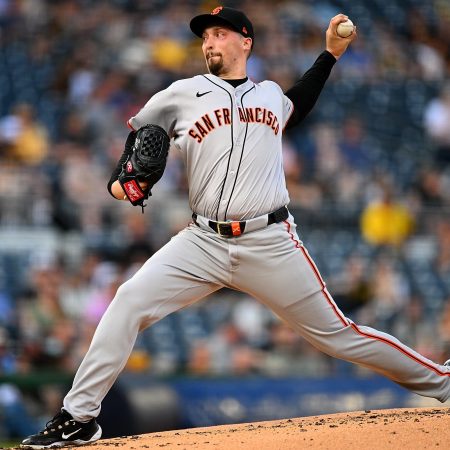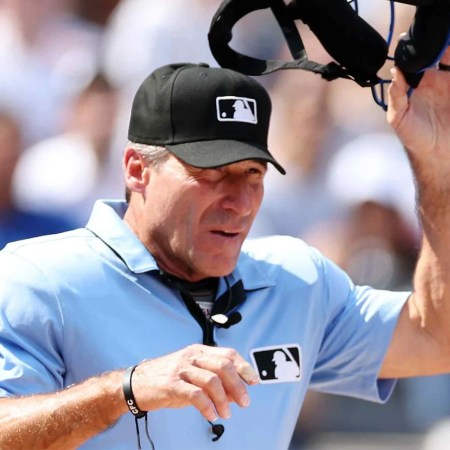Not exactly a big-name star on his way to a Cy Young award, Seattle Mariner reliever Hector Santiago was ejected from Sunday’s game and had his glove confiscated after umpires found something suspicious when they checked him for a foreign substance in the fifth inning.
The first pitcher to be tossed from a game as part of MLB’s crackdown on the use of sticky substances, Santiago had a record of 33-31 with an ERA of 4.53 with 500 strikeouts and two saves in 149 appearances between the 2015 and 2020 seasons with the Twins, White Sox and Mets. This season, the 33-year-old lefty is 1-1 with an ERA of 2.65 and 23 strikeouts in nine appearances for the Mariners. Given the disparity in those ERA numbers, it wouldn’t be at all surprising if it turns out Santiago was using something on the mound other than rosin, as he claimed.
Even if that doesn’t end up being the case and he avoids a 10-game suspension because tests on his glove come back clean, MLB’s crackdown on banned substances has been the biggest storyline in baseball over the past week, and Santiago will probably not be the last pitcher to be busted for having something sticky on his hat, glove or belt buckle.
But is it all the hand-wringing actually accomplishing anything?
We know the crackdown has spawned the must-follow MLB Foreign Substance Checks account on Twitter and led to a number of epic mound meltdowns, but determining whether enforcement of the new rules is having an impact on the game is a bit more difficult to prove.
MLB sent out a memo informing teams on June 3 that sticky substances other than rosin would not be tolerated in tandem with SI publishing an inflammatory piece about how rampant and blatant cheating had become. “Unfortunately, the enhanced monitoring we implemented at the start of the season has had no impact on the behavior of many pitchers,’’ MLB said in the memo sent to every club. “The information we collected over the first two months of the season shows that the use of foreign substances by pitchers is more prevalent than we anticipated.”
It certainly was, as the spin rate on pitches — which is what pitchers are hoping to increase by using sticky stuff — across the league has dropped dramatically since early June. Spin rates, when controlled for velocity, are at their lowest levels since 2015, according to USA Today. Since June 3, teams have averaged 4.59 runs per game compared to 4.36 beforehand. The League batting average has also risen, from .236 to .244 as of Monday.
In the week after the League actually started enforcing its new policy about doctoring the baseball (June 21-27), batting average in the American League was .242 compared to .224 in the National League, for a league average of .232. So even though batting average in MLB is up overall since the league announced sanctions against doctoring the baseball, batting average across the NL and AL is actually down since those sanctions came into effect last Monday. It appears that although pitchers might be annoyed about no longer being able to use goop on the mound, it hasn’t actually hurt them that much against opposing hitters, at least on average.
In specific cases, though, the announcement of penalties and the onset of banned-substance checks has clearly had an effect.
For example, Garrett Richards of the Red Sox, a veteran right-hander whose exceptional spin rate was considered one of his strongest attributes, was 4-4 with an ERA of 3.75 and 52 strikeouts in 11 appearances this season prior to June 3. Since then, Richards has an 0-1 record with an ERA of 8.44 and 12 strikeouts in four appearances prior to last night. Note the huge changes to not just his ERA, but also the vast reduction in the strikeout rate.
“Going through a little transition period right now,” Richards said after his out on Wednesday, per RedSox.com. “Changing some grips on some of my pitches, learning new pitches, just trying to figure this whole thing out. Like I said, a little transition period, still determined to get it figured out. I’m an athlete. I’d like to think I’m going to be able to get over this and figure out a way to get it done.”
Richards, a journeyman, is far from the only pitcher having issues getting it done without doctoring the baseball, as aces like Gerrit Cole of the Yankees and Trevor Bauer of the Dodgers have also struggled mightily since June 3. Prior to the 3rd, Cole was 6-2 with an ERA of 1.78 and 97 strikeouts in 11 appearances. In his four appearances since, Cole has gone 2-1 with an ERA of 3.81 and 25 strikeouts in 4 appearances since. Bauer, meanwhile, went 6-3 with an ERA of 2.24 and 96 strikeouts in 12 appearances before the sanctions. In his four outings since, he’s 1-2 with an ERA of 3.55 and 33 strikeouts. Unlike Richards, Bauer has kept his strikeout rate steady. Cole, on the other hand, has gone from averaging more than 12 strikeouts per nine innings to averaging just 8.65 Ks per nine.
“It was a joke the way the pitchers were cheating,’’ San Diego Padres outfielder Tommy Pham told USA Today. “Guys were coming back to the dugout all of the time saying, ‘That’s the best slider I’ve ever seen.’ I mean, before the crowds came back, you could actually hear the Spider Tack [traction] off guys’ fingers. I could tell you who was cheating on every team I faced. I don’t think people really understand the benefits of it, but we as baseball players do. If your ball is moving more and it’s sharper, that makes it harder to square up. We were playing whiffle ball out there.’’
To a certain extent, at least according to the numbers, that’s no longer really the case. For one team, the Rangers, it is unquestionably not: Texas went from averaging 3.92 runs per game (25th in the majors) to scoring 5.86 runs per game over the seven games since MLB’s crackdown began last week.Their one-week change of 49.4% was the biggest in baseball, per The Dallas Morning News.
While not every MLB team has been able to match that level of success over the last week, it does appear the crackdown has offense looking up. Will that continue? If Richards, Cole or Trevor Bauer are on the mound, it seems likely. We’ll have to see for the rest of MLB.
The Charge will help you move better, think clearer and stay in the game longer. Subscribe to our wellness newsletter today.

























